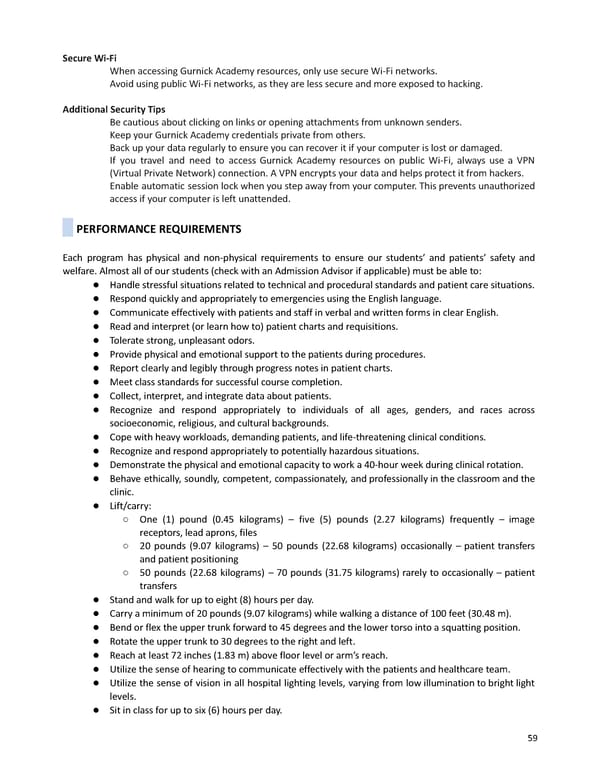SecureWi-Fi WhenaccessingGurnickAcademyresources,onlyusesecureWi-Finetworks. AvoidusingpublicWi-Finetworks,astheyarelesssecureandmoreexposedtohacking. Additional Security Tips Becautiousaboutclickingonlinksoropeningattachmentsfromunknownsenders. KeepyourGurnickAcademycredentialsprivatefromothers. Backupyourdataregularlytoensureyoucanrecoveritifyourcomputerislostordamaged. If you travel and need to access Gurnick Academy resources on public Wi-Fi, always use a VPN (Virtual Private Network) connection. A VPN encrypts your data and helps protect it from hackers. Enable automatic session lock when you step away from your computer. This prevents unauthorized access if your computer is left unattended. PERFORMANCEREQUIREMENTS Each program has physical and non-physical requirements to ensure our students’ and patients’ safety and welfare. Almost all of our students (check with an Admission Advisor if applicable) must be able to: ● Handlestressfulsituationsrelatedtotechnicalandproceduralstandardsandpatientcaresituations. ● RespondquicklyandappropriatelytoemergenciesusingtheEnglishlanguage. ● CommunicateeffectivelywithpatientsandstaffinverbalandwrittenformsinclearEnglish. ● Readandinterpret(orlearnhowto)patientchartsandrequisitions. ● Toleratestrong,unpleasantodors. ● Providephysicalandemotionalsupporttothepatientsduringprocedures. ● Reportclearlyandlegiblythroughprogressnotesinpatientcharts. ● Meetclassstandardsforsuccessfulcoursecompletion. ● Collect,interpret, and integrate data about patients. ● Recognize and respond appropriately to individuals of all ages, genders, and races across socioeconomic, religious, and cultural backgrounds. ● Copewithheavyworkloads,demandingpatients,andlife-threateningclinicalconditions. ● Recognizeandrespondappropriatelytopotentiallyhazardoussituations. ● Demonstratethephysicalandemotionalcapacitytoworka40-hourweekduringclinicalrotation. ● Behave ethically, soundly, competent, compassionately, and professionally in the classroom and the clinic. ● Lift/carry: ○ One (1) pound (0.45 kilograms) – five (5) pounds (2.27 kilograms) frequently – image receptors, lead aprons, files ○ 20 pounds (9.07 kilograms) – 50 pounds (22.68 kilograms) occasionally – patient transfers andpatientpositioning ○ 50 pounds (22.68 kilograms) – 70 pounds (31.75 kilograms) rarely to occasionally – patient transfers ● Standandwalkforuptoeight(8)hoursperday. ● Carryaminimumof20pounds(9.07kilograms)whilewalkingadistanceof100feet(30.48m). ● Bendorflextheuppertrunkforwardto45degreesandthelowertorsointoasquattingposition. ● Rotatetheuppertrunkto30degreestotherightandleft. ● Reachatleast72inches(1.83m)abovefloorlevelorarm’sreach. ● Utilizethesenseofhearingtocommunicateeffectivelywiththepatientsandhealthcareteam. ● Utilize the sense of vision in all hospital lighting levels, varying from low illumination to bright light levels. ● Sitinclassforuptosix(6)hoursperday. 59
 2023-2024 | Catalog Page 58 Page 60
2023-2024 | Catalog Page 58 Page 60